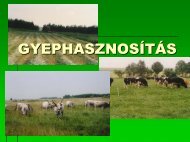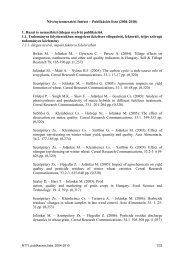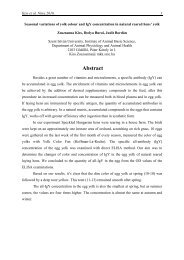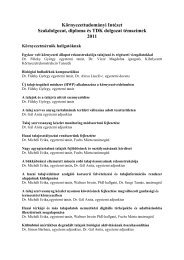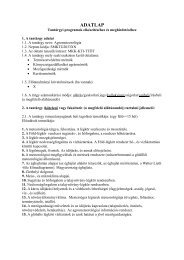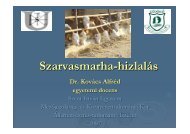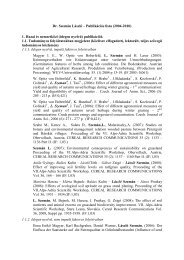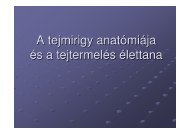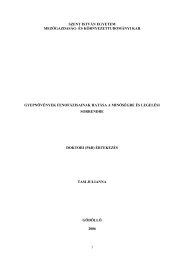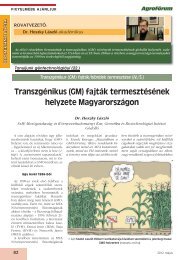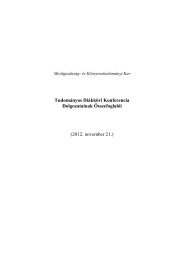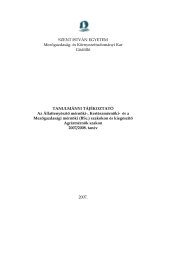Effects of microelements on soil nematode assemblages seven ...
Effects of microelements on soil nematode assemblages seven ...
Effects of microelements on soil nematode assemblages seven ...
You also want an ePaper? Increase the reach of your titles
YUMPU automatically turns print PDFs into web optimized ePapers that Google loves.
Science <str<strong>on</strong>g>of</str<strong>on</strong>g> the Total Envir<strong>on</strong>ment 320 (2004) 131–143<br />
<str<strong>on</strong>g>Effects</str<strong>on</strong>g> <str<strong>on</strong>g>of</str<strong>on</strong>g> <str<strong>on</strong>g>microelements</str<strong>on</strong>g> <strong>on</strong> <strong>soil</strong> <strong>nematode</strong> <strong>assemblages</strong> <strong>seven</strong><br />
years after c<strong>on</strong>taminating an agricultural field<br />
a, a b c a a<br />
Peter ´ Nagy *, Gabor ´ Bak<strong>on</strong>yi , Tom B<strong>on</strong>gers , Imre Kadar ´ ´ , Miklos ´ Fabian ´ ´ , Istvan ´ Kiss<br />
a Department <str<strong>on</strong>g>of</str<strong>on</strong>g> Zoology and Ecology, Szent Istvan ´ University, Godollo, ¨ ¨ ¨ Pater ´ K. u. 1 H-2103, Hungary<br />
bLaboratory<br />
for Nematology, Wageningen University, P.O. Box 8123, Wageningen 6700 ES, The Netherlands<br />
Research Institute for Soil Science and Agricultural Chemistry <str<strong>on</strong>g>of</str<strong>on</strong>g> the Hungarian Academy <str<strong>on</strong>g>of</str<strong>on</strong>g> Sciences, Herman O. u. 15,<br />
Budapest H-1025, Hungary<br />
c<br />
Abstract<br />
Received 28 January 2003; accepted 13 August 2003<br />
L<strong>on</strong>g-term effects <str<strong>on</strong>g>of</str<strong>on</strong>g> Cd, Cr, Cu, Se and Zn were studied 7 years after artificially c<strong>on</strong>taminating plots <str<strong>on</strong>g>of</str<strong>on</strong>g> an<br />
agricultural field <strong>on</strong> a calcareous chernozem <strong>soil</strong>.<str<strong>on</strong>g>Effects</str<strong>on</strong>g> <str<strong>on</strong>g>of</str<strong>on</strong>g> three to four different c<strong>on</strong>taminati<strong>on</strong> levels (originally<br />
y1 y1<br />
10, 30, 90 and 270 mg kg ) were studied.Nematode density was significantly reduced by 90 and 270 mg kg Se<br />
y1 y1<br />
as well as by 270 mg kg Cr, while 90 and 270 mg kg Se also reduced <strong>nematode</strong> generic richness.Maturity<br />
Index values (calculated for c-p 2–5 <strong>nematode</strong>s) c<strong>on</strong>sistently decreased with increasing Cr and Se c<strong>on</strong>centrati<strong>on</strong> and<br />
to a lesser extent in Zn plots as well.Structure Index showed decreasing trends in increasing Cr, Se and (to a lesser<br />
extent) in Zn treatments, while in Cd it shows a moderate increase.Distributi<strong>on</strong> <str<strong>on</strong>g>of</str<strong>on</strong>g> c-p groups was negatively affected<br />
by the increasing Cr and Se c<strong>on</strong>centrati<strong>on</strong>, while in Zn plots, this decrease was not significant.Resp<strong>on</strong>se <str<strong>on</strong>g>of</str<strong>on</strong>g> feeding<br />
groups to polluti<strong>on</strong>s was similar to other parameters: Cr and Se caused significant changes toward the loss <str<strong>on</strong>g>of</str<strong>on</strong>g><br />
variability.The proporti<strong>on</strong> <str<strong>on</strong>g>of</str<strong>on</strong>g> the most sensitive omnivorous and predatory <strong>nematode</strong>s decreased clearly as a<br />
c<strong>on</strong>sequence <str<strong>on</strong>g>of</str<strong>on</strong>g> Cr and Se treatments.Zn polluti<strong>on</strong> also resulted in a slight decrease in this group, while Cd caused<br />
an increase.Nematode diversity pr<str<strong>on</strong>g>of</str<strong>on</strong>g>iles showed a significant decrease in the plots <str<strong>on</strong>g>of</str<strong>on</strong>g> increased Cr and Se<br />
c<strong>on</strong>centrati<strong>on</strong>s, while increased c<strong>on</strong>centrati<strong>on</strong>s <str<strong>on</strong>g>of</str<strong>on</strong>g> Cu and Zn resulted in ambiguous effects.Besides providing evidence<br />
<strong>on</strong> the harmful effects <str<strong>on</strong>g>of</str<strong>on</strong>g> Cr and Se <strong>on</strong> a <strong>soil</strong> <strong>nematode</strong> assemblage, our results suggest that simultaneous analysis <str<strong>on</strong>g>of</str<strong>on</strong>g><br />
Maturity Index, Structure Index and diversity pr<str<strong>on</strong>g>of</str<strong>on</strong>g>iles provide a promising tool in nematological indicati<strong>on</strong> <str<strong>on</strong>g>of</str<strong>on</strong>g> <strong>soil</strong><br />
polluti<strong>on</strong>.<br />
2003 Elsevier B.V. All rights reserved.<br />
Keywords: Soil polluti<strong>on</strong>; Microelement c<strong>on</strong>centrati<strong>on</strong> gradients; Nematodes; Maturity index; Structure index; Diversity pr<str<strong>on</strong>g>of</str<strong>on</strong>g>iles;<br />
Heavy metals<br />
1. Introducti<strong>on</strong><br />
Increasing anthropogenic polluti<strong>on</strong> <str<strong>on</strong>g>of</str<strong>on</strong>g> ecosystems<br />
by heavy metals and <str<strong>on</strong>g>microelements</str<strong>on</strong>g> means<br />
*Corresp<strong>on</strong>ding author.Fax: q36-28-410804.<br />
E-mail address: nagypeterdr@freemail.hu (P.Nagy).<br />
0048-9697/04/$ - see fr<strong>on</strong>t matter 2003 Elsevier B.V. All rights reserved.<br />
doi:10.1016/j.scitotenv.2003.08.006<br />
a growing hazard to living organisms, including<br />
mankind.In spite <str<strong>on</strong>g>of</str<strong>on</strong>g> this fact, data <strong>on</strong> l<strong>on</strong>g-term<br />
effects <str<strong>on</strong>g>of</str<strong>on</strong>g> heavy metals <strong>on</strong> <strong>soil</strong> biota are scarce to<br />
find.A unique l<strong>on</strong>g-term field experiment in Hungary<br />
has been providing opportunities since 1991<br />
to study l<strong>on</strong>g-term effects <str<strong>on</strong>g>of</str<strong>on</strong>g> plant micr<strong>on</strong>utrients,
132 P. Nagy et al. / Science <str<strong>on</strong>g>of</str<strong>on</strong>g> the Total Envir<strong>on</strong>ment 320 (2004) 131–143<br />
including heavy metals <strong>on</strong> <strong>soil</strong> biota, crops and<br />
their c<strong>on</strong>sumers (Kadar, ´ ´ 1994).<br />
Various crops grown at this site in previous<br />
years gave different resp<strong>on</strong>ses to the c<strong>on</strong>taminati<strong>on</strong><br />
(Kadar, ´ ´ 1995).As a general trend, high Se exposure<br />
had a str<strong>on</strong>g phytotoxic effect <strong>on</strong> all grown<br />
crop species (maize, carrot, potato, peas, beet,<br />
spinach, winter wheat and sunflower) and this<br />
effect did not disappear since the start <str<strong>on</strong>g>of</str<strong>on</strong>g> the<br />
experiment.Deleterious effects <str<strong>on</strong>g>of</str<strong>on</strong>g> Se <strong>on</strong> nodulati<strong>on</strong>,<br />
nitrogen-fixati<strong>on</strong> and arbuscular endomycorrhizal<br />
col<strong>on</strong>isati<strong>on</strong> were also detected 4 years after<br />
the applicati<strong>on</strong> (Biro´ et al., 1998).Cr proved to<br />
be toxic for plants in the first 6 years <str<strong>on</strong>g>of</str<strong>on</strong>g> the<br />
experiment.Thereafter, no toxic effect was found.<br />
Cd was not toxic during the first 4 years, but<br />
significantly decreased plant producti<strong>on</strong> from the<br />
5th year <str<strong>on</strong>g>of</str<strong>on</strong>g> the experiment until 2002.It is not<br />
clear whether this result is due to the increased<br />
toxicity <str<strong>on</strong>g>of</str<strong>on</strong>g> Cd or to the planting <str<strong>on</strong>g>of</str<strong>on</strong>g> more Cdsensitive<br />
plant species during these years.Cu and<br />
Zn caused no phytotoxic effects at all.<br />
Nematodes are <str<strong>on</strong>g>of</str<strong>on</strong>g>ten used as indicators <str<strong>on</strong>g>of</str<strong>on</strong>g> envir<strong>on</strong>mental<br />
disturbances, including heavy metal polluti<strong>on</strong><br />
(e.g.: Zullini and Peretti, 1986; Samoil<str<strong>on</strong>g>of</str<strong>on</strong>g>f,<br />
1987; B<strong>on</strong>gers, 1990; Korthals et al., 1996a).<br />
There are, however, <strong>on</strong>ly a limited number <str<strong>on</strong>g>of</str<strong>on</strong>g><br />
studies <strong>on</strong> plant <str<strong>on</strong>g>microelements</str<strong>on</strong>g> under c<strong>on</strong>diti<strong>on</strong>s at<br />
least partly comparable to the present study regarding<br />
c<strong>on</strong>taminati<strong>on</strong> effects <strong>on</strong> <strong>nematode</strong> <strong>assemblages</strong>.In<br />
a microcosm study, Parmelee et al.<br />
(1993) found Cu to decrease <strong>nematode</strong> density in<br />
y1<br />
c<strong>on</strong>centrati<strong>on</strong>s above 200 mg kg .In a microplot<br />
experiment, no remarkable reducti<strong>on</strong> <str<strong>on</strong>g>of</str<strong>on</strong>g> <strong>nematode</strong><br />
density was found in <strong>soil</strong>s polluted with 12 various<br />
<str<strong>on</strong>g>microelements</str<strong>on</strong>g>, except in the V plot, where the<br />
density was 25% <str<strong>on</strong>g>of</str<strong>on</strong>g> the c<strong>on</strong>trol (D.Sturhan,<br />
pers<strong>on</strong>al communicati<strong>on</strong>).<br />
More recently, Korthals et al. (1996b) carried<br />
out an experiment <strong>on</strong> the short-term toxic effects<br />
<str<strong>on</strong>g>of</str<strong>on</strong>g> Cd, Cu, Ni and Zn <strong>on</strong> <strong>nematode</strong> <strong>assemblages</strong><br />
in an acid sandy <strong>soil</strong> collected from a cultivated<br />
field.In their experiment, increased heavy metal<br />
c<strong>on</strong>centrati<strong>on</strong>s resulted in a significant decrease in<br />
density and Maturity Index (MI 2–5).This effect<br />
was significant at the c<strong>on</strong>centrati<strong>on</strong> level <str<strong>on</strong>g>of</str<strong>on</strong>g> 200<br />
y1 mg kg , which is comparable to the maximum<br />
initial c<strong>on</strong>centrati<strong>on</strong>s used in the present experi-<br />
ment.Cd applied in a c<strong>on</strong>centrati<strong>on</strong> <str<strong>on</strong>g>of</str<strong>on</strong>g> 160 mg<br />
y1 kg as a maximum had no significant effect <strong>on</strong><br />
<strong>nematode</strong> density.In another paper, Korthals et al.<br />
(1996c) reported effects <str<strong>on</strong>g>of</str<strong>on</strong>g> an aged Cu polluti<strong>on</strong><br />
and pH levels <strong>on</strong> <strong>nematode</strong> assemblage <str<strong>on</strong>g>of</str<strong>on</strong>g> an<br />
experimental field polluted 10 years earlier.Cu<br />
effects <strong>on</strong> the Maturity Index (MI 2–5) showed a<br />
clear stepwise trend al<strong>on</strong>g a c<strong>on</strong>centrati<strong>on</strong> gradient<br />
y1<br />
<str<strong>on</strong>g>of</str<strong>on</strong>g> 250, 500, 750 kg ha and were largely<br />
enhanced by decreasing <strong>soil</strong> pH within a range <str<strong>on</strong>g>of</str<strong>on</strong>g><br />
3.9–5.5.<br />
In a field site c<strong>on</strong>taminated l<strong>on</strong>g before sampling,<br />
Weiss and Larink (1991) found adverse<br />
effects <str<strong>on</strong>g>of</str<strong>on</strong>g> a mixture <str<strong>on</strong>g>of</str<strong>on</strong>g> heavy metals (am<strong>on</strong>g which<br />
Cd, Cr, Cu and Zn were also involved in this<br />
study) and sewage sludge.In terms <str<strong>on</strong>g>of</str<strong>on</strong>g> density,<br />
<strong>nematode</strong>s gave a positive reacti<strong>on</strong> to this interventi<strong>on</strong>,<br />
due to the high numbers <str<strong>on</strong>g>of</str<strong>on</strong>g> enrichment<br />
opportunists.However, c<strong>on</strong>taminati<strong>on</strong> markedly<br />
decreased omnivorous <strong>nematode</strong>s.In another study<br />
<strong>on</strong> applicati<strong>on</strong> <str<strong>on</strong>g>of</str<strong>on</strong>g> sewage sludge c<strong>on</strong>taminated with<br />
various heavy metals, Georgieva et al. (2002)<br />
found Cu and Zn to have a negative effect <strong>on</strong><br />
various parameters <str<strong>on</strong>g>of</str<strong>on</strong>g> a <strong>nematode</strong> assemblage <strong>on</strong><br />
a sandy loam in England.Cu, Zn and ZnqCu<br />
decreased tax<strong>on</strong> richness and MI, affected c-p<br />
group and feeding group distributi<strong>on</strong>.<br />
In our previous study (Nagy, 1999), certain<br />
elements were found to affect <strong>nematode</strong> <strong>assemblages</strong><br />
<str<strong>on</strong>g>of</str<strong>on</strong>g> the same experimental field.Cr and<br />
especially Se had a negative influence while Zn<br />
appeared to stimulate <strong>nematode</strong>s in terms <str<strong>on</strong>g>of</str<strong>on</strong>g> density,<br />
generic richness and Maturity Index 6 years<br />
after the c<strong>on</strong>taminati<strong>on</strong>.No effects were found,<br />
however, for Al, As, Ba, Cu, Hg, Mo, Ni, Pb and<br />
Sr.Regarding l<strong>on</strong>g-term observati<strong>on</strong>s (Bak<strong>on</strong>yi et<br />
al., 2003), Cr and especially Se showed harmful<br />
effects even 10 years after the c<strong>on</strong>taminati<strong>on</strong>,<br />
while the advantageous effects <str<strong>on</strong>g>of</str<strong>on</strong>g> Zn disappeared.<br />
However, remarkable fluctuati<strong>on</strong>s have been found<br />
in the compositi<strong>on</strong> <str<strong>on</strong>g>of</str<strong>on</strong>g> <strong>nematode</strong> assemblage am<strong>on</strong>g<br />
the studied years.<br />
The aim <str<strong>on</strong>g>of</str<strong>on</strong>g> our study was to evaluate whether<br />
different doses <str<strong>on</strong>g>of</str<strong>on</strong>g> Cd, Cr, Cu, Se and Zn had<br />
recognisable effects <strong>on</strong> the structure <str<strong>on</strong>g>of</str<strong>on</strong>g> the <strong>nematode</strong><br />
<strong>assemblages</strong> in the calcareous chernozem <strong>soil</strong><br />
<str<strong>on</strong>g>of</str<strong>on</strong>g> an agricultural field 7 years after applicati<strong>on</strong>.<br />
Particular emphasis was given to applying coen-
P. Nagy et al. / Science <str<strong>on</strong>g>of</str<strong>on</strong>g> the Total Envir<strong>on</strong>ment 320 (2004) 131–143<br />
ological methods in order to see whether various<br />
nematological indicators, such as tax<strong>on</strong> richness,<br />
MI, SI, c-p group distributi<strong>on</strong> and feeding dominance<br />
lead to similar c<strong>on</strong>clusi<strong>on</strong>s regarding the<br />
given disturbance.<br />
2. Materials and methods<br />
Soil samples were collected from the experimental<br />
field <str<strong>on</strong>g>of</str<strong>on</strong>g> Research Institute for Soil Science<br />
and Agricultural Chemistry (RISSAC) <str<strong>on</strong>g>of</str<strong>on</strong>g> the Hungarian<br />
Academy <str<strong>on</strong>g>of</str<strong>on</strong>g> Sciences at Nagyhorcsok, ¨ ¨ Hungary<br />
(UTM-code: CT 00).Soil characteristics and<br />
experimental design are detailed by Kadar ´ ´ (1994,<br />
1995).Therefore, <strong>on</strong>ly some <str<strong>on</strong>g>of</str<strong>on</strong>g> the most important<br />
<strong>soil</strong> characteristics are menti<strong>on</strong>ed here.The <strong>soil</strong> <str<strong>on</strong>g>of</str<strong>on</strong>g><br />
the experimental plots is a calcareous loamy chernozem<br />
with medium to deep humus layer formed<br />
<strong>on</strong> loess.Exchangeable cati<strong>on</strong>s comprise <str<strong>on</strong>g>of</str<strong>on</strong>g> 80%<br />
Ca, 16% Mg, 3% K, 1% Na.Ss40 meqy100 g,<br />
water soluble saltss1 meqy100 g, pH s7.4.<br />
KCl<br />
( )<br />
Particle distributi<strong>on</strong> in percentage <str<strong>on</strong>g>of</str<strong>on</strong>g> mineral c<strong>on</strong>tent<br />
was as follows.Coarse sand: 0.8%, fine sand:<br />
15.7%, silt: 60.4%, clay: 23.1%. Soil organic<br />
matter c<strong>on</strong>tent was approximately 3%, with a C:N<br />
ratio <str<strong>on</strong>g>of</str<strong>on</strong>g> 8–8.5. Experimental plots were polluted<br />
with single <str<strong>on</strong>g>microelements</str<strong>on</strong>g> given as CdSO ,<br />
4<br />
K CrO , CuSO , Na SeO and ZnSO , respective-<br />
2 4 4 2 3 4<br />
ly.C<strong>on</strong>taminants were ploughed into the <strong>soil</strong> <str<strong>on</strong>g>of</str<strong>on</strong>g><br />
the plots in April 1991.Initial total element doses<br />
y1<br />
were 90, 270 and 810 kg ha .These doses were<br />
y1 y1<br />
roughly equal to 30 mg kg , 90 mg kg and<br />
y1<br />
270 mg kg , respectively, based <strong>on</strong> the typical<br />
<strong>soil</strong> density value <str<strong>on</strong>g>of</str<strong>on</strong>g> 1.5 and the average plough<br />
layer <str<strong>on</strong>g>of</str<strong>on</strong>g> 0.2 m. In the case <str<strong>on</strong>g>of</str<strong>on</strong>g> Cd and Se, an<br />
y1<br />
additi<strong>on</strong>al treatment <str<strong>on</strong>g>of</str<strong>on</strong>g> 10 mg kg in total c<strong>on</strong>-<br />
centrati<strong>on</strong> was also applied.Fertilisers were given<br />
y1 y1<br />
at c<strong>on</strong>centrati<strong>on</strong>s <str<strong>on</strong>g>of</str<strong>on</strong>g> Ns100 kg ha year (as<br />
y1 y1<br />
NH4NO 3), P2O5s100 kg ha year , Ks100<br />
y1 y1<br />
kg ha year .P, K and half <str<strong>on</strong>g>of</str<strong>on</strong>g> the N dose were<br />
applied before the autumn tillage, while the sec<strong>on</strong>d<br />
half <str<strong>on</strong>g>of</str<strong>on</strong>g> N was applied in early spring.The above<br />
treatments are aimed to assess the effects <str<strong>on</strong>g>of</str<strong>on</strong>g><br />
<str<strong>on</strong>g>microelements</str<strong>on</strong>g> <strong>on</strong> crops grown under c<strong>on</strong>diti<strong>on</strong>s<br />
<str<strong>on</strong>g>of</str<strong>on</strong>g> regular cropping systems.No pesticides were<br />
applied, weed c<strong>on</strong>trol was performed by manual<br />
cultivati<strong>on</strong>.Experimental units were arranged in a<br />
split-plot design encompassing an area <str<strong>on</strong>g>of</str<strong>on</strong>g> 21 m2 133<br />
per plot.Each plot was surrounded by paths <str<strong>on</strong>g>of</str<strong>on</strong>g> 1<br />
m width.The two replicates were set up as two<br />
adjacent blocks <str<strong>on</strong>g>of</str<strong>on</strong>g> plots.Both replicates <str<strong>on</strong>g>of</str<strong>on</strong>g> each<br />
treatment and two c<strong>on</strong>trol plots were sampled <strong>on</strong><br />
30 June 1998, 7 years after the c<strong>on</strong>taminati<strong>on</strong>.<br />
The NH4-acetateqEDTA soluble (mobile) fracti<strong>on</strong><br />
<str<strong>on</strong>g>of</str<strong>on</strong>g> element was determined according to Lak-<br />
anen and Ervio ¨ (1971).These analyses were<br />
performed in 1991, 1992, 1994 and 1997.Sunflower<br />
(Helianthus annuus L.) was grown in the<br />
experimental field in 1998.By the date <str<strong>on</strong>g>of</str<strong>on</strong>g> sampling<br />
it was close to flowering.<br />
For nematological analysis composite samples<br />
(20 subsampleyplot) <str<strong>on</strong>g>of</str<strong>on</strong>g> approximately 300–400 g<br />
<strong>soil</strong> were taken using a <strong>soil</strong> corer <str<strong>on</strong>g>of</str<strong>on</strong>g> 2 cm in<br />
diameter.The top 10 cm <str<strong>on</strong>g>of</str<strong>on</strong>g> <strong>soil</strong> was sampled.<br />
Nematodes were extracted from <strong>soil</strong> using Cobb’s<br />
decanting and sieving method (modified according<br />
to s’Jacob and van Bezooijen, 1984), and enumerated<br />
(typically approx.20% <str<strong>on</strong>g>of</str<strong>on</strong>g> the obtained suspensi<strong>on</strong>).Then<br />
after fixing with 80–90 8C hot<br />
formalin (cc.8%), samples were stored until further<br />
processing, during which at least 150 specimens<br />
per sample were identified, possibly to genus<br />
level.This process resulted in <strong>nematode</strong> tax<strong>on</strong><br />
richness values (i.e. number <str<strong>on</strong>g>of</str<strong>on</strong>g> <strong>nematode</strong> taxa)<br />
and coenological data for each sample. (In cases<br />
<str<strong>on</strong>g>of</str<strong>on</strong>g> the maximum c<strong>on</strong>centrati<strong>on</strong> Se treatment where<br />
this amount <str<strong>on</strong>g>of</str<strong>on</strong>g> <strong>nematode</strong>s was not available, samples<br />
were processed totally.) As a result, c-p group<br />
distributi<strong>on</strong> patterns and Maturity Index values<br />
were calculated for <strong>nematode</strong> <strong>assemblages</strong> in each<br />
sample according to B<strong>on</strong>gers (1990).Korthals et<br />
al. (1996a) indicated that omitting c-p 1 <strong>nematode</strong>s<br />
that results in a ‘MI (2–5)’ value gives a much<br />
better resp<strong>on</strong>se to disturbances than the MI<br />
(including c-p 1).The reas<strong>on</strong> for this is that taxa<br />
in c-p 1 group react to <strong>soil</strong> organic enrichment as<br />
well.When calculating c-p distributi<strong>on</strong>, intermediate<br />
taxa <str<strong>on</strong>g>of</str<strong>on</strong>g> c-p 3 were assigned to the c<strong>on</strong>glomerate<br />
<str<strong>on</strong>g>of</str<strong>on</strong>g> c-p 4–5 (persister <strong>nematode</strong>s).However,<br />
representatives <str<strong>on</strong>g>of</str<strong>on</strong>g> the c-p 3 group occurred in <strong>on</strong>ly<br />
27% <str<strong>on</strong>g>of</str<strong>on</strong>g> the samples where their average proporti<strong>on</strong><br />
was as low as 0.75%. Structure Index (SI) values<br />
(Ferris et al., 2001) were also computed.SI is a<br />
measure <str<strong>on</strong>g>of</str<strong>on</strong>g> the stabile and structured status <str<strong>on</strong>g>of</str<strong>on</strong>g> a<br />
<strong>soil</strong> <strong>nematode</strong> community.It is based <strong>on</strong> the<br />
proporti<strong>on</strong> <str<strong>on</strong>g>of</str<strong>on</strong>g> feeding types combined with their
134 P. Nagy et al. / Science <str<strong>on</strong>g>of</str<strong>on</strong>g> the Total Envir<strong>on</strong>ment 320 (2004) 131–143<br />
appropriate guild weightings.High value shows a<br />
more structured community, while low SI is a sign<br />
<str<strong>on</strong>g>of</str<strong>on</strong>g> ‘basal c<strong>on</strong>diti<strong>on</strong>s’, i.e. previous disturbance.<br />
Nematode taxa were assigned to feeding types<br />
sensu Yeates et al. (1993).<br />
Data were analysed using <strong>on</strong>e-way ANOVA to<br />
discover significant differences in <strong>nematode</strong> density<br />
as well as <strong>nematode</strong> generic richness values.<br />
For density values, correlati<strong>on</strong> was also calculated<br />
al<strong>on</strong>g the c<strong>on</strong>centrati<strong>on</strong> gradient.The significant<br />
differences in c-p group distributi<strong>on</strong>s were tested<br />
2<br />
with standard Pears<strong>on</strong> x test.<br />
Most <str<strong>on</strong>g>of</str<strong>on</strong>g> the classical diversity indices have the<br />
serious disadvantage <str<strong>on</strong>g>of</str<strong>on</strong>g> varying in sensitivity to<br />
the density <str<strong>on</strong>g>of</str<strong>on</strong>g> the comm<strong>on</strong> and rare species.To<br />
overcome this problem, Patil and Taillie (1979)<br />
suggested the use <str<strong>on</strong>g>of</str<strong>on</strong>g> the community diversity<br />
pr<str<strong>on</strong>g>of</str<strong>on</strong>g>ile.The community diversity pr<str<strong>on</strong>g>of</str<strong>on</strong>g>ile outlines<br />
scale-dependent diversity <str<strong>on</strong>g>of</str<strong>on</strong>g> a community.Some<br />
values <str<strong>on</strong>g>of</str<strong>on</strong>g> the diversity pr<str<strong>on</strong>g>of</str<strong>on</strong>g>ile are related to classical<br />
diversity indexes, namely at as0 equal to<br />
lgS, where Ssnumber <str<strong>on</strong>g>of</str<strong>on</strong>g> species in the community,<br />
at as1 equal to the value <str<strong>on</strong>g>of</str<strong>on</strong>g> the Shann<strong>on</strong><br />
index etc.Tothmeresz ´ ´ ´ (1993) developed new<br />
diversity functi<strong>on</strong> families and the computer program<br />
package DivOrd.In this study, DivOrd 1.50<br />
was used to calculate diversity pr<str<strong>on</strong>g>of</str<strong>on</strong>g>iles.Diversity<br />
pr<str<strong>on</strong>g>of</str<strong>on</strong>g>iles between scale parameters 0–40 <str<strong>on</strong>g>of</str<strong>on</strong>g> all plots<br />
were generated.The low values refer to the rare<br />
taxa, while the higher scale parameters depict the<br />
status <str<strong>on</strong>g>of</str<strong>on</strong>g> the more frequent <strong>on</strong>es.Above as4, the<br />
curves were more or less parallel to each other,<br />
therefore, diversity pr<str<strong>on</strong>g>of</str<strong>on</strong>g>iles between as0 and 4<br />
are presented.Significant differences can be found<br />
am<strong>on</strong>g 2 curves when these do not cross each<br />
other and Renyi ´ diversity values for the points <str<strong>on</strong>g>of</str<strong>on</strong>g><br />
the curves differ at Ps5%.In this study, curves<br />
have been compared with an increment <str<strong>on</strong>g>of</str<strong>on</strong>g> 0.5<br />
al<strong>on</strong>g the range <str<strong>on</strong>g>of</str<strong>on</strong>g> as0–4.<br />
3. Results<br />
The mobile fracti<strong>on</strong>s <str<strong>on</strong>g>of</str<strong>on</strong>g> the target element in<br />
the studied plots are shown in Table 1.These data<br />
show that the actual available values differed<br />
(<str<strong>on</strong>g>of</str<strong>on</strong>g>ten remarkably) from the originally added total<br />
values (depending <strong>on</strong> the pollutant).However, a<br />
trend <str<strong>on</strong>g>of</str<strong>on</strong>g> increasing c<strong>on</strong>centrati<strong>on</strong>s over the dose<br />
gradient was still well recognisable 6 years after<br />
the c<strong>on</strong>taminati<strong>on</strong>.<br />
In general, increased microelement c<strong>on</strong>centrati<strong>on</strong>s<br />
decreased <strong>nematode</strong> density in all cases<br />
except Cu.Nematode density was significantly<br />
lower than the c<strong>on</strong>trol in the Se treatments at 90<br />
y1<br />
and 270 mg kg c<strong>on</strong>centrati<strong>on</strong> and in the plots<br />
<str<strong>on</strong>g>of</str<strong>on</strong>g> the highest Cr c<strong>on</strong>taminati<strong>on</strong>, 270 mg kgy1 (Table 2).There were significant correlati<strong>on</strong>s<br />
between microelement c<strong>on</strong>centrati<strong>on</strong> and <strong>nematode</strong><br />
density in Cr, Se and Zn treatments (P-0.05).<br />
Nematode tax<strong>on</strong> richness values were decreased<br />
y1<br />
significantly by the 90 and 270 mg kg Se<br />
treatment (Table 3).The increasing c<strong>on</strong>centrati<strong>on</strong>s<br />
<str<strong>on</strong>g>of</str<strong>on</strong>g> the other elements did not correlate with this<br />
parameter.However, this could be due to the<br />
relatively low richness and high S.D. values in<br />
certain cases (Cr, Cu).<br />
Nematode MI (2–5) values (Table 4) were<br />
c<strong>on</strong>sistently lower in the Cr treatments <str<strong>on</strong>g>of</str<strong>on</strong>g> the 270<br />
y1 mg kg c<strong>on</strong>centrati<strong>on</strong> and in the Se treatments<br />
y1<br />
from 30 mg kg <strong>on</strong>wards, according to a clear<br />
dose-related pattern.The low number <str<strong>on</strong>g>of</str<strong>on</strong>g> <strong>nematode</strong>s<br />
y1<br />
extracted from the 270 mg kg Se-plots made it<br />
impossible to calculate MI for this treatment.For<br />
Zn, a slight decrease appeared with the increasing<br />
c<strong>on</strong>centrati<strong>on</strong>, while in Cd samples there was a<br />
little increase in MI toward the highest treatment<br />
investigated.No trend could be observed in Cutreated<br />
samples.<br />
The c-p group distributi<strong>on</strong> <str<strong>on</strong>g>of</str<strong>on</strong>g> samples was also<br />
significantly affected by Cr and Se polluti<strong>on</strong> levels<br />
(Table 5).Cu c<strong>on</strong>taminati<strong>on</strong> induced no c<strong>on</strong>sistent<br />
resp<strong>on</strong>se.This parameter was not sensitive to Cd<br />
and Zn treatment.The c-p 3–5 <strong>nematode</strong>s occurred<br />
y1<br />
in relatively high proporti<strong>on</strong> in 270 mg kg Cd<br />
and Cu samples.<br />
Structure Index (SI) values are displayed in<br />
Table 6.This parameter shows clear decreasing<br />
trends in Cr, Se and (to a lesser extent) in Zn<br />
treatments, while in Cd it shows a moderate<br />
increase.In the values <str<strong>on</strong>g>of</str<strong>on</strong>g> the Cu treatments there<br />
is no obvious trend.<br />
Feeding group dominance data are shown in<br />
Table 7.Regarding bacterial feeders, Cr and Se<br />
more or less increased, Cd, Cu and Zn decreased<br />
this parameter compared to the c<strong>on</strong>trol.Fungal<br />
feeders were enhanced by all treatments, except
P. Nagy et al. / Science <str<strong>on</strong>g>of</str<strong>on</strong>g> the Total Envir<strong>on</strong>ment 320 (2004) 131–143<br />
Table 1<br />
The NH4-acetateqEDTA soluble (mobile) c<strong>on</strong>centrati<strong>on</strong> values al<strong>on</strong>g the microelement gradients as measured in the subsequent<br />
analyses<br />
Element, year C<strong>on</strong>trol 10 mg kg y1 30 mg kg y1 90 mg kg y1 270 mg kg y1<br />
Cd<br />
1991 – 14.0 27.0 96.0 270.0<br />
1992 – 0 18.0 62.0 228.0<br />
1994 – 0 14.0 44.0 164.0<br />
1997 – 0 26.8 84.7 190.0<br />
2000<br />
Cr<br />
– 0 14.0 44.0 124.0<br />
1991 0 – 1.0 3.0 9.0<br />
1992 0 – 2.0 5.0 10.0<br />
1994 0 – 1.0 2.0 4.0<br />
1997 0.2 – 0.45 0.77 1.4<br />
2000<br />
Cu<br />
0 – 0.4 0.9 1.6<br />
1991 9.0 – 29.0 47.0 200.0<br />
1992 4.0 – 34.0 94.0 270.0<br />
1994 4.0 – 23.0 65.0 192.0<br />
1997 6.0 – 19.4 54.1 133.0<br />
2000<br />
Se<br />
4.0 – 20.0 44.0 128.0<br />
1991 – 1.0 6.0 34.0 84.0<br />
1992 – 0 7.0 66.0 81.0<br />
1994 – 0 8.0 33.0 89.0<br />
1997 – 0.5 1.56 9.32 36.0<br />
2000<br />
Zn<br />
– 0 2.0 4.0 11.0<br />
1991 1.0 – 22.0 66.0 120.0<br />
1992 3.0 – 29.0 68.0 213.0<br />
1994 1.0 – 19.0 44.0 147.0<br />
1997 2.0 – 22.0 53.0 143.0<br />
2000 2.0 – 16.0 37.0 85.0<br />
–: no such treatment.<br />
Table 2<br />
y1<br />
<str<strong>on</strong>g>Effects</str<strong>on</strong>g> <str<strong>on</strong>g>of</str<strong>on</strong>g> pollutant c<strong>on</strong>centrati<strong>on</strong> gradients <strong>on</strong> <strong>nematode</strong> density; average specimenU100 g <strong>soil</strong> ("S.D.)<br />
Element 0mgkg y1 10 mg kg y1 30 mg kg y1 90 mg kg y1 270 mg kg y1<br />
C<strong>on</strong>trol 1275.0 ("1104) – – – –<br />
Cd – x 1105.0 ("824) 937.5 ("735) 815.0 ("613)<br />
Cr x – 1055.0 ("754) 834.5 ("724) 484.5 ("267)*<br />
Cu x – 981.0 ("501) 1184.0 ("945) 1063.0 ("987)<br />
Se – 1160.0 ("587) 954.0 ("861) 422.5 ("370)* 20.0 ("3.5)**<br />
Zn x – 1150.0 ("1033) 1021.0 ("648) 882.5 ("628)<br />
–: no such treatment, x: not sampled, *: significant decrease in respective values, P-0.05, **: significant decrease in respective<br />
value, P-0.01.<br />
135
136 P. Nagy et al. / Science <str<strong>on</strong>g>of</str<strong>on</strong>g> the Total Envir<strong>on</strong>ment 320 (2004) 131–143<br />
Table 3<br />
<str<strong>on</strong>g>Effects</str<strong>on</strong>g> <str<strong>on</strong>g>of</str<strong>on</strong>g> pollutant c<strong>on</strong>centrati<strong>on</strong> gradients <strong>on</strong> <strong>nematode</strong> tax<strong>on</strong> richness; average values ("S.D.)<br />
Element 0mgkg y1 10 mg kg y1 30 mg kg y1 90 mg kg y1 270 mg kg y1<br />
C<strong>on</strong>trol 19.0 ("2.8) – – – –<br />
Cd – x 22.5 ("2.1) 17.0 ("y) 18.0 (0)<br />
Cr x – 20.5 ("0.7) 16.0 (0) 15.0 ("2.8)<br />
Cu x – 21.0 ("1.4) 15.5 ("0.7) 17.5 ("5.0)<br />
Se – 16.5 ("2.1) 16.0 ("2.8) 12.5 ("2.1)* 3. 0 ("1.4)*<br />
Zn x – 18.5 ("2.1) 18.5 ("0.7) 18.5 ("2.1)<br />
–: no such treatment, x: not sampled, y: no data available, *: significant decrease in respective values, P-5%.<br />
the maximum Se level.As for predators and<br />
omnivores, this group was very sensitive to high<br />
Cr and Se levels, while in other treatments showed<br />
ratios comparable to the c<strong>on</strong>trol.<br />
Bacterial feeders and fungal feeders being differently<br />
sensitive to heavy metal and microelement<br />
polluti<strong>on</strong>, BFyFF ratio was displayed separately in<br />
Table 8.Based <strong>on</strong> this parameter, bacterial feeders<br />
became dominant under higher Se c<strong>on</strong>centrati<strong>on</strong>s<br />
y1<br />
(90 and 270 mg kg ), while increasing Cd and<br />
Cu levels favoured fungal feeders.<br />
Diversity-pr<str<strong>on</strong>g>of</str<strong>on</strong>g>iles for <strong>nematode</strong> samples were<br />
obviously affected by some <str<strong>on</strong>g>of</str<strong>on</strong>g> the treatments.Cd<br />
polluti<strong>on</strong> did not result in a clear trend <str<strong>on</strong>g>of</str<strong>on</strong>g> diversity<br />
pr<str<strong>on</strong>g>of</str<strong>on</strong>g>iles (Fig.1).The lowest level <str<strong>on</strong>g>of</str<strong>on</strong>g> Cr seemed<br />
to have slightly stimulated <strong>nematode</strong> diversity<br />
while the two highest <strong>on</strong>es resulted in a significant<br />
decrease, though there was an adverse trend<br />
between these latter: the highest level <str<strong>on</strong>g>of</str<strong>on</strong>g> c<strong>on</strong>taminant<br />
was more depressive for the rare taxa than<br />
for the most comm<strong>on</strong> <strong>on</strong>es (Fig.2).In the Cu<br />
treated plots, the highest level treatment resulted<br />
in lower diversity values than the others (except<br />
for the rare taxa) and there was an overall trend<br />
<str<strong>on</strong>g>of</str<strong>on</strong>g> decrease with increasing c<strong>on</strong>centrati<strong>on</strong> (Fig.3).<br />
Table 4<br />
<str<strong>on</strong>g>Effects</str<strong>on</strong>g> <str<strong>on</strong>g>of</str<strong>on</strong>g> pollutant c<strong>on</strong>centrati<strong>on</strong> gradients <strong>on</strong> Maturity Index (2–5); average values ("S.D.)<br />
For Se treatments, a slight to moderate polluti<strong>on</strong><br />
y1<br />
(up to 90 mg kg ) kept diversity pr<str<strong>on</strong>g>of</str<strong>on</strong>g>iles around<br />
y1<br />
the c<strong>on</strong>trol level and <strong>on</strong>ly 270 mg kg caused a<br />
massively significant decrease in diversity (Fig.<br />
4).The Zn levels resulted in a remarkable pattern:<br />
no significant differences were found for the whole<br />
diversity pr<str<strong>on</strong>g>of</str<strong>on</strong>g>ile for most treatments, but the highest<br />
c<strong>on</strong>centrati<strong>on</strong> slightly increased diversity compared<br />
to the two lowest <strong>on</strong>es for rare taxa, while<br />
the frequent taxa appeared to become much less<br />
diverse (Fig.5).<br />
4. Discussi<strong>on</strong><br />
<str<strong>on</strong>g>Effects</str<strong>on</strong>g> <str<strong>on</strong>g>of</str<strong>on</strong>g> Cd <strong>on</strong> <strong>soil</strong> <strong>nematode</strong>s were not<br />
significant in terms <str<strong>on</strong>g>of</str<strong>on</strong>g> most parameters.Only BFy<br />
FF ratio was decreased by the increasing c<strong>on</strong>centrati<strong>on</strong><br />
and the diversity pr<str<strong>on</strong>g>of</str<strong>on</strong>g>ile seemed to benefit<br />
y1<br />
from the 30 mg kg treatment, i.e. LOEC (Low-<br />
est Observable Effect C<strong>on</strong>centrati<strong>on</strong>) value <str<strong>on</strong>g>of</str<strong>on</strong>g> Cd<br />
under present c<strong>on</strong>diti<strong>on</strong>s should be above the<br />
y1<br />
theoretical level <str<strong>on</strong>g>of</str<strong>on</strong>g> 270 mg kg applied as max-<br />
imum rate (In available c<strong>on</strong>centrati<strong>on</strong> it was equal<br />
y1<br />
to approx.190 mg kg ).This finding is in<br />
agreement with Kammenga et al. (1994) who<br />
Element 0mgkg y1 10 mg kg y1 30 mg kg y1 90 mg kg y1 270 mg kg y1<br />
C<strong>on</strong>trol 2.45 ("0.11) – – – –<br />
Cd – x 2.25 ("0.13) 2.3 ("y) 2.57 ("0.09)<br />
Cr x – 2.33 ("0.13) 2.22 ("0.18) 2.03 ("0.04)<br />
Cu x – 2.34 ("0.1) 2.11 ("0.06) 2.42 ("0.18)<br />
Se – 2.52 ("0.06) 2.19 ("0.08) 2.05 ("0.01) n.c.<br />
Zn x – 2.42 ("0.05) 2.39 ("0.04) 2.33 ("0.13)<br />
–: no such treatment, x: not sampled, y: no data available, n.c.: not calculable due to the too low <strong>nematode</strong> density.
P. Nagy et al. / Science <str<strong>on</strong>g>of</str<strong>on</strong>g> the Total Envir<strong>on</strong>ment 320 (2004) 131–143<br />
Table 5<br />
<str<strong>on</strong>g>Effects</str<strong>on</strong>g> <str<strong>on</strong>g>of</str<strong>on</strong>g> pollutant c<strong>on</strong>centrati<strong>on</strong> gradients <strong>on</strong> the c-p group distributi<strong>on</strong> patterns <str<strong>on</strong>g>of</str<strong>on</strong>g> n<strong>on</strong>-plant feeding <strong>nematode</strong>s; average values<br />
Element 0mgkg y1 10 mg kg y1 30 mg kg y1 90 mg kg y1 270 mg kg y1<br />
C<strong>on</strong>trol<br />
c-p 1(%) 3. 5 – – – –<br />
c-p 2(%) 79.7 – – – –<br />
c-p 3–5(%)<br />
Cd<br />
16.9 – – – –<br />
c-p 1(%) – x 4.0 2.4 1.1<br />
c-p 2(%) – x 85.8 87.2 79.2<br />
c-p 3–5(%) – x 10.1 10.4 19.9<br />
P-<br />
Cr<br />
n.s. n.s. n.s.<br />
c-p 1(%) x – 2.0 0.7 0.7<br />
c-p 2(%) x – 86.0 90.0 98.8<br />
c-p 3–5(%) x – 12.3 9.0 0.8<br />
P-<br />
Cu<br />
n.s. 0.01 0.001<br />
c-p 1(%) x – 1.7 1.3 0.9<br />
c-p 2(%) x – 85.9 94.8 83.0<br />
c-p 3–5(%) x – 12.2 4.3 16.1<br />
P-<br />
Se<br />
n.s. 0.001 n.s.<br />
c-p 1(%) – 0.8 1.3 6.0 n.c.<br />
c-p 2(%) – 81.2 92.6 92.6 n.c.<br />
c-p 3–5(%) – 18.2 5.9 1.5 n.c.<br />
P-<br />
Zn<br />
n.s. 0.01 0.001<br />
c-p 1(%) x – 0.9 1.4 1.6<br />
c-p 2(%) x – 83.9 84.6 86.3<br />
c-p 3–5(%) x – 15.2 14.2 12.0<br />
P- n.s. n.s. n.s.<br />
–: no such treatment, x: not sampled, n.c.: not calculable due to the too low <strong>nematode</strong> density, P-significance level compared<br />
2<br />
to the c<strong>on</strong>trol resulting from the x test, n.s.: n<strong>on</strong>-significant.<br />
found <strong>nematode</strong>s to be relatively insensitive to Cd,<br />
compared to other <strong>soil</strong> animals.Though the cited<br />
study was carried out in vitro with a short-term<br />
Table 6<br />
<str<strong>on</strong>g>Effects</str<strong>on</strong>g> <str<strong>on</strong>g>of</str<strong>on</strong>g> pollutant c<strong>on</strong>centrati<strong>on</strong> gradients <strong>on</strong> SI; average values ("S.D.)<br />
Element 0mgkg y1 10 mg kg y1 30 mg kg y1 90 mg kg y1 270 mg kg y1<br />
C<strong>on</strong>trol 52.69("7.8) – – – –<br />
Cd – x 35.04 ("13.3) 40.59 ("y) 59.42 ("4.2)<br />
Cr x – 42.64 ("11.3) 31.01 ("20.7) 10.12 (0)<br />
Cu x – 47.24 ("10.3) 26.52 ("6.0) 49.58 ("13.3)<br />
Se – 56.93("3.6) 28.58 ("9.4) 9.12 ("0.8) n.c.<br />
Zn x – 50.60 ("3.7) 48.49 ("2.0) 43.16 ("10.8)<br />
–: no such treatment, x: not sampled, y: no data available, n.c. not calculable due to the too low <strong>nematode</strong> density.<br />
137<br />
aspect, it included 12 <strong>nematode</strong> species <str<strong>on</strong>g>of</str<strong>on</strong>g> various<br />
feeding and life-strategy groups, which made its<br />
c<strong>on</strong>clusi<strong>on</strong>s more realistic than usual single-species
138 P. Nagy et al. / Science <str<strong>on</strong>g>of</str<strong>on</strong>g> the Total Envir<strong>on</strong>ment 320 (2004) 131–143<br />
Table 7<br />
<str<strong>on</strong>g>Effects</str<strong>on</strong>g> <str<strong>on</strong>g>of</str<strong>on</strong>g> pollutant c<strong>on</strong>centrati<strong>on</strong> gradients <strong>on</strong> feeding group ratios; average percentage values<br />
Element 0mgkg y1 10 mg kg y1 30 mg kg y1 90 mg kg y1 270 mg kg y1<br />
C<strong>on</strong>trol<br />
BF 34.4 – – – –<br />
FF 21.9 – – – –<br />
PqO 9. 1 – – – –<br />
PF<br />
Cd<br />
34.6 – – – –<br />
BF – x 42.5 36.0 28.7<br />
FF – x 30.3 29.1 35.2<br />
PqO – x 6.5 6.3 13.8<br />
PF – x 20.7 28.6 22.3<br />
P- 0.01 n.s. 0.01<br />
Cr x –<br />
BF x – 32.8 47.2 43.2<br />
FF x – 34.3 36.9 41.1<br />
PqO x – 7.2 5.0 0.6<br />
PF 25.7 10.9 15.0<br />
P-<br />
Cu<br />
0.05 0.001 0.001<br />
BF – 34.2 29.1 22.5<br />
FF x – 30.0 32.5 33.9<br />
PqO x – 7.6 2.7 7.2<br />
PF x – 28.2 35.7 36.3<br />
P-<br />
Se<br />
n.s. 0.05 0.05<br />
BF – 32.3 39.8 56.2 n.c.<br />
FF – 27.1 30.6 30.6 n.c.<br />
PqO – 12.1 4.1 1.0 n.c.<br />
PF – 28.4 25.5 12.2 n.c.<br />
P-<br />
Zn<br />
n.s. 0.05 0.001<br />
BF x – 21.2 26.8 20.0<br />
FF x – 31.8 31.7 31.1<br />
PqO x – 7.2 7.9 6.0<br />
PF x – 39.7 33.7 42.9<br />
P- 0.05 n.s. 0.01<br />
BF: bacterial feeders, FF: fungal feeders, PqO: predatorsqomnivores, PF: plant feeders, –: no such treatment, x: not sampled,<br />
2<br />
n.c.: not calculable due to the too low <strong>nematode</strong> density, P-significance level compared to the c<strong>on</strong>trol resulting from the x test,<br />
n.s.: n<strong>on</strong>-significant.<br />
laboratory tests.Korthals et al.(1996b) also found<br />
<strong>nematode</strong> fauna uneffected by Cd up to 160 mg<br />
y1 kg (though in a short-term study).<br />
<str<strong>on</strong>g>Effects</str<strong>on</strong>g> <str<strong>on</strong>g>of</str<strong>on</strong>g> Cr <strong>on</strong> <strong>nematode</strong> <strong>assemblages</strong> have so<br />
far been paid little attenti<strong>on</strong> to.Yeates et al.(1995)<br />
presented results <strong>on</strong> mixed effects <str<strong>on</strong>g>of</str<strong>on</strong>g> As, Cr and<br />
Cu but their data are hard to compare with ours<br />
due to the different approach (multi- vs.singleelement<br />
treatment).In his study D.Sturhan (per-<br />
s<strong>on</strong>al communicati<strong>on</strong>) showed an MI-decrease for<br />
Cr.In our present experiment, Cr had still a<br />
negative impact <strong>on</strong> <strong>nematode</strong> <strong>assemblages</strong>, similarly<br />
to earlier results (Nagy, 1999).Increasing<br />
c<strong>on</strong>centrati<strong>on</strong> <str<strong>on</strong>g>of</str<strong>on</strong>g> this element affected most <str<strong>on</strong>g>of</str<strong>on</strong>g> the<br />
parameters applied to indicate disturbance <strong>on</strong> <strong>nematode</strong><br />
assemblage.Density, tax<strong>on</strong> richness, MI, SI,<br />
PqO ratio and proporti<strong>on</strong> <str<strong>on</strong>g>of</str<strong>on</strong>g> c-p 3–5 <strong>nematode</strong>s<br />
all clearly decreased al<strong>on</strong>g the c<strong>on</strong>centrati<strong>on</strong> gra-
P. Nagy et al. / Science <str<strong>on</strong>g>of</str<strong>on</strong>g> the Total Envir<strong>on</strong>ment 320 (2004) 131–143<br />
Table 8<br />
<str<strong>on</strong>g>Effects</str<strong>on</strong>g> <str<strong>on</strong>g>of</str<strong>on</strong>g> pollutant c<strong>on</strong>centrati<strong>on</strong> gradients <strong>on</strong> bacterial feederyfungal feeder ratios; average values ("S.D.)<br />
Element 0mgkg y1 10 mg kg y1 30 mg kg y1 90 mg kg y1 270 mg kg y1<br />
C<strong>on</strong>trol 1.90 ("1.4) – – – –<br />
Cd – x 1.52 ("0.6) 1.24 ("y) 0.82 ("0.1)<br />
Cr x – 1.00 ("0.3) 1.29 ("0.2) 1.14 ("0.5)<br />
Cu x – 1.14 ("0.2) 0.92 ("0.3) 0.66 ("0.0)<br />
Se – 1.19 ("0.46) 1.36 ("0.2) 1.95("0.6) n.c.<br />
Zn x – 0.68 ("0.1) 0.85 ("0.2) 0.64 ("0.0)<br />
–: no such treatment, x: not sampled, y: no data available, n.c. not calculable due to the too low <strong>nematode</strong> density, BF: bacterial<br />
feeders, FF: fungal feeders.<br />
Fig.1.Diversity pr<str<strong>on</strong>g>of</str<strong>on</strong>g>iles for the Cd treatment.Cd 2:30 mg<br />
y1 y1 y1<br />
kg , Cd 3:90 mg kg , Cd 4:270 mg kg .<br />
Fig.2.Diversity pr<str<strong>on</strong>g>of</str<strong>on</strong>g>iles for the Cr treatment.Cr 2:30 mg<br />
y1 y1 y1<br />
kg , Cr 3:90 mg kg , Cr 4:270 mg kg .<br />
139<br />
Fig.3.Diversity pr<str<strong>on</strong>g>of</str<strong>on</strong>g>iles for the Cu treatment.Cu 2:30 mg<br />
y1 y1 y1<br />
kg , Cu 3:90 mg kg , Cu 4:270 mg kg .<br />
dient.Moreover, the diversity pr<str<strong>on</strong>g>of</str<strong>on</strong>g>iles also showed<br />
a significant decrease as a c<strong>on</strong>sequence <str<strong>on</strong>g>of</str<strong>on</strong>g> the 90<br />
y1 mg kg level.Therefore, it can be c<strong>on</strong>cluded that<br />
LOEC value for Cr is approximately 0.5 mg<br />
y1 kg available c<strong>on</strong>centrati<strong>on</strong> (expressed in NH4- acetateqEDTA soluble).In the higher treatments<br />
y1<br />
(90 and 270 mg kg ), where the remaining<br />
y1<br />
available Cr in 1997 was 0.77 mg kg and 1.4<br />
y1 mg kg , respectively, all parameters showed a<br />
c<strong>on</strong>siderable depressi<strong>on</strong>.It is difficult, however, to<br />
quantify what proporti<strong>on</strong> <str<strong>on</strong>g>of</str<strong>on</strong>g> available Cr acts in<br />
the <strong>soil</strong> as the more toxic Cr(VI) form.<br />
In case <str<strong>on</strong>g>of</str<strong>on</strong>g> the Cu gradients, no obvious resp<strong>on</strong>se<br />
<str<strong>on</strong>g>of</str<strong>on</strong>g> <strong>nematode</strong>s could be observed based <strong>on</strong> the most<br />
parameters.Only diversity pr<str<strong>on</strong>g>of</str<strong>on</strong>g>iles showed a more<br />
or less c<strong>on</strong>sistent stepwise difference suggesting<br />
y1<br />
that 90 and 270 mg kg c<strong>on</strong>centrati<strong>on</strong>s might
140 P. Nagy et al. / Science <str<strong>on</strong>g>of</str<strong>on</strong>g> the Total Envir<strong>on</strong>ment 320 (2004) 131–143<br />
Fig.4.Diversity pr<str<strong>on</strong>g>of</str<strong>on</strong>g>iles for the Se treatment.Se 1:10 mg<br />
y1 y1 y1<br />
kg , Se 2:30 mg kg , Se 3:90 mg kg , Se 4:270 mg<br />
kg . y1<br />
have an unfavourable effect <strong>on</strong> <strong>nematode</strong><br />
<strong>assemblages</strong>.<br />
Korthals et al. (1996c) observed several clear<br />
effects <strong>on</strong> <strong>nematode</strong> trophic structure <str<strong>on</strong>g>of</str<strong>on</strong>g> a field<br />
c<strong>on</strong>taminated with a Cu c<strong>on</strong>centrati<strong>on</strong> gradient 10<br />
years prior to sampling.In the most comparable<br />
case, where actual pH was 5.5 (originally 6.1)<br />
total numbers were similar al<strong>on</strong>g the whole c<strong>on</strong>centrati<strong>on</strong><br />
gradient.Bacterial feeders slightly, fungal<br />
feeders remarkably increased with higher Cu<br />
levels.Plant <strong>nematode</strong>s showed no c<strong>on</strong>sistent reacti<strong>on</strong>.Omnivorous<br />
and carnivorous <strong>nematode</strong>s<br />
decreased al<strong>on</strong>g the c<strong>on</strong>centrati<strong>on</strong> gradient.These<br />
Fig.5.Diversity pr<str<strong>on</strong>g>of</str<strong>on</strong>g>iles for the Zn treatment.Zn 2:30 mg<br />
y1 y1 y1<br />
kg , Zn 3:90 mg kg , Zn 4:270 mg kg .<br />
results are partly in line with our findings: fungal<br />
feeders seemed to slightly benefit from the increasing<br />
Cu levels and the BFyFF ratio decreased.Also,<br />
plant feeders fluctuated around basically the same<br />
percentage value.However, in our study there was<br />
no systematic decrease in the number <str<strong>on</strong>g>of</str<strong>on</strong>g> omnivorous<br />
and carnivorous <strong>nematode</strong>s and bacterial feeders<br />
rather decreased than increased in their<br />
proporti<strong>on</strong>.The probable main reas<strong>on</strong>s for the<br />
partly dissimilar findings can be the different pH<br />
values and <strong>soil</strong> type.Under present c<strong>on</strong>diti<strong>on</strong>s,<br />
<strong>nematode</strong>s did not appear to be particularly sensitive<br />
to Cu up to an available c<strong>on</strong>centrati<strong>on</strong> level<br />
<str<strong>on</strong>g>of</str<strong>on</strong>g> approximately 130 mg kg . y1<br />
The relatively high proporti<strong>on</strong> <str<strong>on</strong>g>of</str<strong>on</strong>g> c-p 3–5 nem-<br />
y1<br />
atodes in 270 mg kg Cd and Cu samples may<br />
be due to the insensitivity <str<strong>on</strong>g>of</str<strong>on</strong>g> this group <str<strong>on</strong>g>of</str<strong>on</strong>g> persister<br />
<strong>nematode</strong>s to the given metals or an increase in<br />
algal growth in the upper millimetres <str<strong>on</strong>g>of</str<strong>on</strong>g> the <strong>soil</strong>,<br />
where the heavy metals had been washed out.<br />
The most expressed effects <strong>on</strong> target parameters<br />
in this experiment were observed in the Se treat-<br />
y1<br />
ments.The first c<strong>on</strong>centrati<strong>on</strong> level (10 mg kg )<br />
slightly increased <strong>nematode</strong> MI, while the two<br />
y1<br />
higher c<strong>on</strong>centrati<strong>on</strong>s (30 and 90 mg kg ) result-<br />
ed in a clearly detectable decrease in all the studied<br />
<strong>nematode</strong> parameters.In the plots <str<strong>on</strong>g>of</str<strong>on</strong>g> highest dose<br />
y1<br />
(270 mg kg ) there were not enough <strong>nematode</strong>s<br />
to calculate indices.It should also be pointed out,<br />
however, that the remarkable negative effects <str<strong>on</strong>g>of</str<strong>on</strong>g><br />
Se might partly be due to the almost complete<br />
y1<br />
lack <str<strong>on</strong>g>of</str<strong>on</strong>g> vegetati<strong>on</strong> in the 270 mg kg plots.This<br />
assumpti<strong>on</strong> is supported by the observati<strong>on</strong>s that<br />
terrestrial <strong>nematode</strong>s are without respect to their<br />
feeding types, closely c<strong>on</strong>nected to vegetati<strong>on</strong> <str<strong>on</strong>g>of</str<strong>on</strong>g><br />
a field (Freckman and Caswell, 1985; Yeates,<br />
1987).It requires further studies to discriminate<br />
between direct and indirect (plant-mediated) toxic<br />
effects <str<strong>on</strong>g>of</str<strong>on</strong>g> high Se loads.<br />
Zn has apparently lost its previously shown<br />
(Nagy, 1999) favourable character for the <strong>soil</strong><br />
<strong>nematode</strong> assemblage by the time <str<strong>on</strong>g>of</str<strong>on</strong>g> the present<br />
experiment.N<strong>on</strong>e <str<strong>on</strong>g>of</str<strong>on</strong>g> the c<strong>on</strong>centrati<strong>on</strong> levels had<br />
any significant effect <strong>on</strong> any <str<strong>on</strong>g>of</str<strong>on</strong>g> the parameters <str<strong>on</strong>g>of</str<strong>on</strong>g><br />
the studied <strong>soil</strong> invertebrate group.The <strong>on</strong>ly indicati<strong>on</strong><br />
<str<strong>on</strong>g>of</str<strong>on</strong>g> its earlier positive effect was that the<br />
diversity <str<strong>on</strong>g>of</str<strong>on</strong>g> the rare taxa was higher in plots <str<strong>on</strong>g>of</str<strong>on</strong>g><br />
high than <str<strong>on</strong>g>of</str<strong>on</strong>g> low Zn levels.Diversity <str<strong>on</strong>g>of</str<strong>on</strong>g> the
P. Nagy et al. / Science <str<strong>on</strong>g>of</str<strong>on</strong>g> the Total Envir<strong>on</strong>ment 320 (2004) 131–143<br />
frequent taxa showed, however, an opposite trend.<br />
Nematode density, MI, SI values showed, though<br />
not significantly, a decrease with the increasing<br />
c<strong>on</strong>centrati<strong>on</strong>s <str<strong>on</strong>g>of</str<strong>on</strong>g> Zn.These findings appear to be<br />
in line with the results <str<strong>on</strong>g>of</str<strong>on</strong>g> Korthals et al. (1996b)<br />
who found Zn to depress <strong>nematode</strong>s in a c<strong>on</strong>cen-<br />
y1trati<strong>on</strong><br />
<str<strong>on</strong>g>of</str<strong>on</strong>g> 200 mg kg during a short-term exper-<br />
iment.In our l<strong>on</strong>g-term study performed under<br />
more favourable <strong>soil</strong> c<strong>on</strong>diti<strong>on</strong>s, Zn doses <str<strong>on</strong>g>of</str<strong>on</strong>g><br />
approximately 140 ppm available c<strong>on</strong>centrati<strong>on</strong> in<br />
plots <str<strong>on</strong>g>of</str<strong>on</strong>g> the maximum treatment gave the first<br />
signs <str<strong>on</strong>g>of</str<strong>on</strong>g> destructi<strong>on</strong> for the <strong>nematode</strong> fauna.In a<br />
recent paper, Georgieva et al. (2002) reported<br />
several negative effects <str<strong>on</strong>g>of</str<strong>on</strong>g> Zn, Cu and ZnqCu<br />
treatments <strong>on</strong> <strong>nematode</strong>s in an English agroecosystem<br />
<strong>on</strong> a sandy loam treated with sewage<br />
sludge.The metal levels applied by them extended<br />
to a higher level (e.g. for Zn: 160–600 mg kg y1<br />
in total c<strong>on</strong>centrati<strong>on</strong>) than in our case.It should<br />
be pointed out, however, that repeated sewage<br />
sludge applicati<strong>on</strong> means a more realistic, but less<br />
c<strong>on</strong>trollable treatment than ploughing in a given<br />
amount <str<strong>on</strong>g>of</str<strong>on</strong>g> metal salt at the start <str<strong>on</strong>g>of</str<strong>on</strong>g> the experiment;<br />
the latter is easily washed out and biologically<br />
more available.<br />
Density decreased significantly by Cr and Se<br />
c<strong>on</strong>centrati<strong>on</strong> gradient, while in Cd and Zn plots,<br />
it showed a n<strong>on</strong>-significant decline.The former<br />
can be attributed to a severe destructi<strong>on</strong>, since<br />
pure <strong>nematode</strong> density is a rather insensitive<br />
parameter (B<strong>on</strong>gers, 1990).<br />
Richness <str<strong>on</strong>g>of</str<strong>on</strong>g> <strong>nematode</strong> taxa is a more sensitive<br />
parameter <str<strong>on</strong>g>of</str<strong>on</strong>g> activity <str<strong>on</strong>g>of</str<strong>on</strong>g> nemat<str<strong>on</strong>g>of</str<strong>on</strong>g>auna as well as<br />
<strong>soil</strong> nitrogen status and decompositi<strong>on</strong> functi<strong>on</strong><br />
(Ekschmitt et al., 1999).In our study, richness<br />
was slightly decreased by increasing Cr and<br />
remarkably decreased by the subsequent steps <str<strong>on</strong>g>of</str<strong>on</strong>g><br />
Se treatment.The other pollutants did not generate<br />
any clear effect.<br />
The clear stepwise resp<strong>on</strong>se <str<strong>on</strong>g>of</str<strong>on</strong>g> Maturity Index<br />
and Structure Index to Cr and Se treatments also<br />
underlines the destructive character <str<strong>on</strong>g>of</str<strong>on</strong>g> these pollutants.The<br />
c-p distributi<strong>on</strong> <str<strong>on</strong>g>of</str<strong>on</strong>g> samples shows very<br />
clearly the sensitivity <str<strong>on</strong>g>of</str<strong>on</strong>g> the ‘persisters’ to Cr and<br />
Se polluti<strong>on</strong>.The c-p 3 <strong>nematode</strong>s being very rare,<br />
the apparent trends in this parameter can be attributed<br />
to the sensitivity <str<strong>on</strong>g>of</str<strong>on</strong>g> the K-strategist <strong>nematode</strong>s<br />
(in this case bel<strong>on</strong>ging mostly to the order Dory-<br />
141<br />
laimida).This is in accordance with B<strong>on</strong>gers<br />
(1990, 1999).Zullini and Peretti (1986) found a<br />
similar phenomen<strong>on</strong> for lead (Pb) polluti<strong>on</strong>.<br />
Regarding distributi<strong>on</strong> <str<strong>on</strong>g>of</str<strong>on</strong>g> feeding groups: the<br />
percentage dominance bacterial feeders (chiefly<br />
Acrobeloides, Chiloplacus and Heterocephalobus)<br />
clearly increase al<strong>on</strong>g the c<strong>on</strong>centrati<strong>on</strong> gradients<br />
<str<strong>on</strong>g>of</str<strong>on</strong>g> Cr and Se.In the light <str<strong>on</strong>g>of</str<strong>on</strong>g> other parameters, this<br />
indicates the relative insensitivity <str<strong>on</strong>g>of</str<strong>on</strong>g> this group to<br />
the given disturbances.It is remarkable how dominant<br />
Chiloplacus is in the 90 and 270 ppm Seplots.This<br />
indicates a c<strong>on</strong>siderable tolerance for<br />
Se, at least compared to other <strong>nematode</strong> taxa that<br />
occur in the studied area.This phenomen<strong>on</strong> has<br />
also been observed earlier, except the stepwise<br />
resp<strong>on</strong>se (Nagy, 1999). Proporti<strong>on</strong> <str<strong>on</strong>g>of</str<strong>on</strong>g> fungal feeding<br />
<strong>nematode</strong>s remains stable (Zn) or slightly<br />
increases (Cd, Cr, Cu), but even in case <str<strong>on</strong>g>of</str<strong>on</strong>g> Se, it<br />
decreases str<strong>on</strong>gly <strong>on</strong>ly in the highest treatment<br />
level.In the latter case, the low value is based <strong>on</strong><br />
the (probably random) occurrence <str<strong>on</strong>g>of</str<strong>on</strong>g> a single<br />
Tylencholaimus.This shows that fungivorous <strong>nematode</strong>s<br />
(dominated by Aphelenchus, Aphelenchoides<br />
and Ditylenchus) were quite insensitive to<br />
most polluti<strong>on</strong>s.This is in agreement with D.<br />
Sturhan (pers<strong>on</strong>al communicati<strong>on</strong>) and Korthals et<br />
al. (1996c), who found Aphelenchoides to tolerate<br />
heavy metal (including Cu) stress.The proporti<strong>on</strong><br />
<str<strong>on</strong>g>of</str<strong>on</strong>g> omnivorous and predatory <strong>nematode</strong>s decreased<br />
clearly as a c<strong>on</strong>sequence <str<strong>on</strong>g>of</str<strong>on</strong>g> Cr and Se treatments.<br />
Zn also resulted in a slight decrease, while to Cd<br />
this group reacted with an increase.Since dominant<br />
representatives <str<strong>on</strong>g>of</str<strong>on</strong>g> this group were in this study<br />
basically the same as the c-p 4–5 <strong>nematode</strong>s, these<br />
results underline the harmful effects <str<strong>on</strong>g>of</str<strong>on</strong>g> Cr and Se<br />
dem<strong>on</strong>strated by the above menti<strong>on</strong>ed parameters<br />
as well.<br />
In general, MI (and the closely related c-p<br />
distributi<strong>on</strong>), SI values and diversity pr<str<strong>on</strong>g>of</str<strong>on</strong>g>iles gave<br />
basically similar indicati<strong>on</strong>s <str<strong>on</strong>g>of</str<strong>on</strong>g> the effects <str<strong>on</strong>g>of</str<strong>on</strong>g> the<br />
studied elements.While for Cr and Se, a clear<br />
depressi<strong>on</strong> could be dem<strong>on</strong>strated and for Zn a<br />
weak depressi<strong>on</strong> appears, Cd generated no sensitivity<br />
and Cu treatments showed no obvious patterns.The<br />
fact that the above parameters <str<strong>on</strong>g>of</str<strong>on</strong>g><br />
different theoretical nature led to comparable c<strong>on</strong>sequences<br />
shows the robustness <str<strong>on</strong>g>of</str<strong>on</strong>g> the present<br />
results.The combined use <str<strong>on</strong>g>of</str<strong>on</strong>g> these tools may be a
142 P. Nagy et al. / Science <str<strong>on</strong>g>of</str<strong>on</strong>g> the Total Envir<strong>on</strong>ment 320 (2004) 131–143<br />
relevant method in field toxicity studies, <str<strong>on</strong>g>of</str<strong>on</strong>g>fering<br />
several advantages compared to single indices.<br />
Such advantages <str<strong>on</strong>g>of</str<strong>on</strong>g> diversity ordering are the firm<br />
background built <strong>on</strong> various diversity indices and<br />
the suitability <str<strong>on</strong>g>of</str<strong>on</strong>g> clear graphic interpretati<strong>on</strong>.However,<br />
the Maturity Index and Structure Index are<br />
easy-to-calculate measures <str<strong>on</strong>g>of</str<strong>on</strong>g> highly relevant<br />
nematological basis (B<strong>on</strong>gers and B<strong>on</strong>gers, 1998;<br />
B<strong>on</strong>gers, 1999; B<strong>on</strong>gers and Ferris, 1999; Ferris<br />
et al., 2001).<br />
In c<strong>on</strong>clusi<strong>on</strong>, both favourable <strong>soil</strong> c<strong>on</strong>diti<strong>on</strong>s<br />
and time elapsed (over 7 years) since the c<strong>on</strong>taminati<strong>on</strong><br />
as well as not very high available element<br />
c<strong>on</strong>centrati<strong>on</strong>s may explain the less pr<strong>on</strong>ounced<br />
effects <str<strong>on</strong>g>of</str<strong>on</strong>g> certain elements (Cd, Cu, Zn).However,<br />
Se and Cr still show significant l<strong>on</strong>g-term effects<br />
<strong>on</strong> terrestrial <strong>nematode</strong>s, an important comp<strong>on</strong>ent<br />
<str<strong>on</strong>g>of</str<strong>on</strong>g> the <strong>soil</strong> biota involved in a crop producti<strong>on</strong><br />
system.<br />
Acknowledgments<br />
This study was supported by a Hungarian-<br />
Flemish Intergovernmental R&D Co-operative<br />
Agreement (C<strong>on</strong>tract No.B15y97) and by the<br />
Ministry <str<strong>on</strong>g>of</str<strong>on</strong>g> Culture and Educati<strong>on</strong> (C<strong>on</strong>tract No.<br />
FKFP 0280y1999).<br />
References<br />
Bak<strong>on</strong>yi G, Nagy P, Kadar ´ ´ I.L<strong>on</strong>g-term effects <str<strong>on</strong>g>of</str<strong>on</strong>g> heavy<br />
metals and <str<strong>on</strong>g>microelements</str<strong>on</strong>g> <strong>on</strong> <strong>nematode</strong> assemblage.Toxicol<br />
Lett 2003;140–141:391 –401.<br />
Biro´ B, Koves-Pechy ¨ ´ K, Voros ¨ ¨ I, Kadar ´ ´ I.Toxicity <str<strong>on</strong>g>of</str<strong>on</strong>g> some<br />
field applied heavy metal salts to the rhizobial and fungal<br />
microsymbi<strong>on</strong>ts <str<strong>on</strong>g>of</str<strong>on</strong>g> alfalfa and red clover.Agrokemia ´ es ´<br />
Talajtan 1998;47:265 –276.<br />
B<strong>on</strong>gers T.The maturity index: an ecological measure <str<strong>on</strong>g>of</str<strong>on</strong>g><br />
envir<strong>on</strong>mental disturbance based <strong>on</strong> <strong>nematode</strong> species compositi<strong>on</strong>.Oecologia<br />
1990;83:14 –19.<br />
B<strong>on</strong>gers T.The maturity index, the evoluti<strong>on</strong> <str<strong>on</strong>g>of</str<strong>on</strong>g> <strong>nematode</strong> life<br />
history traits, adaptive radiati<strong>on</strong> and c-p scaling.Plant Soil<br />
1999;212:13 –22.<br />
B<strong>on</strong>gers T, B<strong>on</strong>gers M.Functi<strong>on</strong>al diversity <str<strong>on</strong>g>of</str<strong>on</strong>g> <strong>nematode</strong>s’.<br />
Appl Soil Ecol 1998;10:239 –251.<br />
B<strong>on</strong>gers T, Ferris H.Nematode community structure as a<br />
bioindicator in envir<strong>on</strong>mental m<strong>on</strong>itoring.TREE<br />
1999;14:224 –228.<br />
Ekschmitt K, Bak<strong>on</strong>yi G, B<strong>on</strong>gers M, B<strong>on</strong>gers T, Bostrom ¨ S,<br />
Dogan H, Harris<strong>on</strong> A, Kallimanis A, Nagy P, O’D<strong>on</strong>nel<br />
AG, Papatheodoru EM, Sohlenius B, Stamou GP, Wolters<br />
V.Nematode community structure as indicator <str<strong>on</strong>g>of</str<strong>on</strong>g> <strong>soil</strong><br />
functi<strong>on</strong>ing in European grassland <strong>soil</strong>s.Eur J Soil Biol<br />
1999;37:263 –268.<br />
Ferris H, B<strong>on</strong>gers T, deGoede RGM.A framework for <strong>soil</strong><br />
food web diagnostics: extensi<strong>on</strong> <str<strong>on</strong>g>of</str<strong>on</strong>g> the <strong>nematode</strong> faunal<br />
analysis c<strong>on</strong>cept.Appl Soil Ecol 2001;18:13 –29.<br />
Freckman DW, Caswell EP.The ecology <str<strong>on</strong>g>of</str<strong>on</strong>g> <strong>nematode</strong>s in<br />
agroecosystems.Annu Rev Phytopathol 1985;23:275 –296.<br />
Georgieva SS, McGrath SP, Hooper DJ, Chambers BS.Nematode<br />
communities under stress: the l<strong>on</strong>g-term effects <str<strong>on</strong>g>of</str<strong>on</strong>g><br />
heavy metals in <strong>soil</strong> treated with sewage sludge.Appl Soil<br />
Ecol 2002;20:27 –42.<br />
Kadar ´ ´ I.Importance <str<strong>on</strong>g>of</str<strong>on</strong>g> l<strong>on</strong>g-term field experiments in sustainable<br />
agriculture for Hungary.Agrokemia ´ es ´ Talajtan<br />
1994;43:291 –304.<br />
Kadar ´ ´ I.A talaj-noveny-allat-ember ¨ ´ ´ taplaleklanc ´ ´ ´ ´ szennyezo- ˜<br />
dese ´ kemiai ´ elemekkel Magyarorszag<strong>on</strong>. ´ wC<strong>on</strong>taminati<strong>on</strong> <str<strong>on</strong>g>of</str<strong>on</strong>g><br />
the <strong>soil</strong>-plant-animal-human food-chain by chemicals in<br />
Hungary.x MTA-TAKI, Budapest, 1995, p.388 (in<br />
Hungarian).<br />
Kammenga JE, Van Gestel CAM, Bakker J.Patterns <str<strong>on</strong>g>of</str<strong>on</strong>g><br />
sensitivity to cadmium and pentachlorophenol am<strong>on</strong>g <strong>nematode</strong><br />
species from different tax<strong>on</strong>omic and ecological<br />
groups.Arch Envir<strong>on</strong> C<strong>on</strong> Tox 1994;27:88 –94.<br />
Korthals GW, deGoede RGM, Kammenga JE, B<strong>on</strong>gers T.The<br />
maturity index as an instrument for risk assessment <str<strong>on</strong>g>of</str<strong>on</strong>g> <strong>soil</strong><br />
polluti<strong>on</strong>.In: vanStraalen NM, Krivolutsky DA, editors.<br />
Bioindicator systems for <strong>soil</strong> polluti<strong>on</strong>Kluwer, 1996a.p.<br />
85 –93.<br />
Korthals GW, van der Ende A, van Megen H, Lexm<strong>on</strong>d TM,<br />
Kammenga JE, B<strong>on</strong>gers T.Short-term effects <str<strong>on</strong>g>of</str<strong>on</strong>g> cadmium,<br />
copper, nickel and zinc <strong>on</strong> <strong>soil</strong> <strong>nematode</strong>s from different<br />
feeding and life-history strategy groups.Appl Soil Ecol<br />
1996b;4:107 –117.<br />
Korthals GW, Alexiev AD, Lexm<strong>on</strong>d TM, Kammenga JE,<br />
B<strong>on</strong>gers T.L<strong>on</strong>g-term effects <str<strong>on</strong>g>of</str<strong>on</strong>g> copper and pH <strong>on</strong> the<br />
<strong>nematode</strong> community in an agroecosystem.Envir<strong>on</strong> Toxicol<br />
Chem 1996c;15:979 –985.<br />
Lakanen E, Ervio¨ R.A comparis<strong>on</strong> <str<strong>on</strong>g>of</str<strong>on</strong>g> eight extractants for the<br />
determinati<strong>on</strong> <str<strong>on</strong>g>of</str<strong>on</strong>g> plant available micr<strong>on</strong>utrients in <strong>soil</strong>.Acta<br />
Agr Finn 1971;123:223 –232.<br />
Nagy P.<str<strong>on</strong>g>Effects</str<strong>on</strong>g> <str<strong>on</strong>g>of</str<strong>on</strong>g> an artificial metal polluti<strong>on</strong> <strong>on</strong> <strong>nematode</strong><br />
assemblage <str<strong>on</strong>g>of</str<strong>on</strong>g> a calcareous loamy chernozem <strong>soil</strong>.Plant<br />
Soil 1999;212:35 –47.<br />
Parmelee RW, Wentsel RS, Philips CT, Simini M, Checkai<br />
RT.Soil microcosm for testing the effects <str<strong>on</strong>g>of</str<strong>on</strong>g> chemical<br />
pollutants <strong>on</strong> <strong>soil</strong> fauna communities and trophic structure.<br />
Envir<strong>on</strong> Toxicol Chem 1993;12:1477 –1486.<br />
Patil GP, Taillie C.An overwiev <str<strong>on</strong>g>of</str<strong>on</strong>g> diversity.In: Grassle JF,<br />
Patil GP, Smith W, Taillie C, editors.Ecological diversity<br />
in theory and practice.Fairland, Maryland: Internati<strong>on</strong>al<br />
Cooperative Publishing House, 1979.p.3 –27.<br />
Samoil<str<strong>on</strong>g>of</str<strong>on</strong>g>f MR.Nematodes as indicators <str<strong>on</strong>g>of</str<strong>on</strong>g> toxic envir<strong>on</strong>mental<br />
c<strong>on</strong>taminants.In: Veech JA, Dicks<strong>on</strong> DW, editors.Vistas<br />
<strong>on</strong> nematology. Florida: E.O. Painter Printer Co., DeLe<strong>on</strong><br />
Springs, 1987.p.433 –439.<br />
s’Jacob JJ, van Bezooijen J.A manual for practical work in<br />
nematologyWageningen Agricultural University Department<br />
<str<strong>on</strong>g>of</str<strong>on</strong>g> Nematology, 1984.p.77
P. Nagy et al. / Science <str<strong>on</strong>g>of</str<strong>on</strong>g> the Total Envir<strong>on</strong>ment 320 (2004) 131–143<br />
Tothmeresz ´ ´ ´ B.DivOrd 1.50.A program for diversity ordering.<br />
Tiscia 1993; 27: 33–44.<br />
Weiss B, Larink O.Influence <str<strong>on</strong>g>of</str<strong>on</strong>g> sewage sludge and heavy<br />
metals <strong>on</strong> <strong>nematode</strong>s in an arable <strong>soil</strong>.Biol Fert Soils<br />
1991;12:5 –9.<br />
Yeates GW.How plants affect <strong>nematode</strong>s.Adv Ecol Res<br />
1987;17:61 –113.<br />
Yeates GW, B<strong>on</strong>gers T, de Goede RGM, Freckman DW,<br />
Georgieva SS.Feeding habits in <strong>soil</strong> <strong>nematode</strong> families and<br />
143<br />
genera: an outline for <strong>soil</strong> ecologists.J Nematol<br />
1993;25:315 –331.<br />
Yeates GW, Orchard VA, Speir TW.Reducti<strong>on</strong> in faunal<br />
populati<strong>on</strong>s and decompositi<strong>on</strong> following pasture c<strong>on</strong>taminati<strong>on</strong><br />
by a Cu–Cr–As based timber preservative.Acta<br />
Zoologica Fennica 1995;196:297 –300.<br />
Zullini A, Peretti E.Lead polluti<strong>on</strong> and moss-inhabiting<br />
<strong>nematode</strong>s <str<strong>on</strong>g>of</str<strong>on</strong>g> an industrial area.Water Air Soil Poll<br />
1986;27:403 –410.



